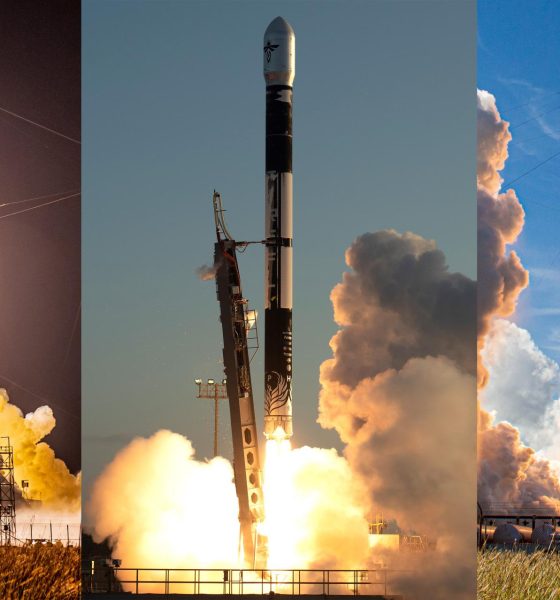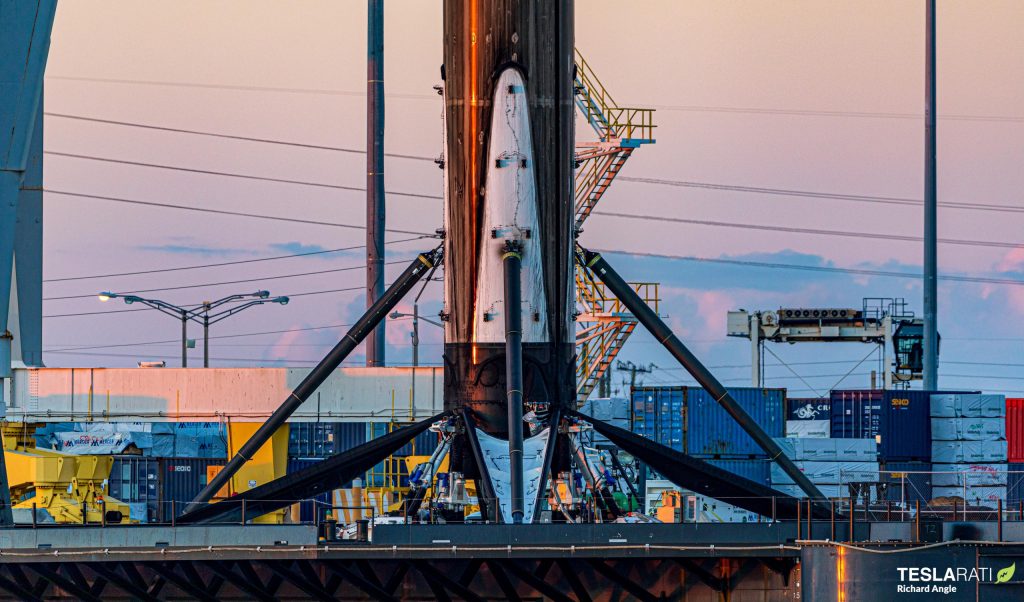

News
SpaceX, Firefly Aerospace targeting three rocket launches in two days
Update: As is a common occurrence in spaceflight, two of the three planned missions have been delayed or scrubbed. Firefly’s second Alpha launch has slipped to no earlier than (NET) September 12th after an aborted attempt on the 11th, and SpaceX’s Starlink 4-34 mission was pushed from September 11th to September 13th.
SpaceX and Firefly Aerospace are on track to attempt three orbital launches this weekend as the former continues to relentlessly assemble a constellation of Starlink internet satellites and the latter works to secure its first success.
On the heels of 40 successful Falcon 9 launches this year, SpaceX is a few days away from two more Starlink missions that will likely leave the company with more than 3000 working satellites in orbit.
Founded in 2017, 15 years after SpaceX, Firefly Aerospace is almost entirely focused on one near-term goal: the first successful launch of its Alpha rocket.
Firefly’s Alpha rocket lifted off for the first time on September 2nd, 2021. Just moments after launch, a faulty cable caused one of the Alpha first stage’s four Reaver engines to shut down, immediately dooming the attempt. The rocket inexplicably persevered, though, and managed more than two minutes of powered flight before it lost control, became a range safety risk, and was terminated.
More than a year later, Firefly believes it has solved the problems that doomed Alpha Flight 1 and is on the cusp of the rocket’s second launch attempt, which has been scheduled no earlier than (NET) 3pm PST (22:00 UTC) on Sunday, September 11th.
Recently, the second fully stacked Alpha rocket completed a wet dress rehearsal and static fire while installed on Firefly’s Vandenberg Space Force Base (VSFB) SLC-2W pad, confirming its readiness for flight. Measuring 1.8 meters (6 ft) wide and 29.5 meters (~95 ft) tall, Alpha is about half the width and height of SpaceX’s Falcon 9 workhorse, and Firefly estimates that the expendable rocket will be able to launch up to 1.17 tons (~2560 lb) to Low Earth Orbit (LEO).
That’s several times more performance per launch than competitors like Rocket Lab, Astra Space, and Virgin Orbit, but 14 times less than a partially reusable Falcon 9. At $15 million apiece, however, the rocket’s list price will be 4.5 times less than Falcon 9’s, which could be enough to create a niche for customers that want to spend a bit more to send smaller satellites exactly where they want instead of getting dropped off in the general vicinity as a rideshare payload.
Demonstrating an impressive level of transparency, Firefly will offer a public livestream of Alpha’s second flight in full awareness that it could ultimately broadcast a launch failure for the second time in a row. There are very few instances in the history of spaceflight where a new group’s new rocket successfully reached orbit on its first launch, so it’s a credit to the startup to acknowledge the reality that launch failures are a common extension of the development process, rather than something to hide from the public.


SpaceX knows that reality well. Falcon 1, its first rocket, was about half the size of Firefly’s Alpha and suffered three launch failures in two and half years before finally succeeding on its fourth attempt. More than a magnitude larger, Falcon 9 likely benefitted from SpaceX’s Falcon 1 experience and had a much smoother start to life, though it did eventually experience its own share of failures years after its 2010 debut.
12 years later, Falcon 9 is one of the most successful launch vehicles of all time, and has simultaneously pioneered the commercially viable reuse of orbital-class rockets. Currently on a historic pace of one launch every ~6.2 days in 2022, Falcon 9 recently completed its 146th successful launch in a row and 173rd successful launch overall.
Hopefully continuing those trends, Next Spaceflight reports that Falcon 9 is scheduled to launch two more batches of Starlink satellites at 9:10 pm EDT on Saturday, September 10th, and 10:53 pm EDT on Sunday, September 11th. In addition to several dozen Starlink satellites, the first mission – Starlink 4-2 – is expected to carry a relatively large 1.5-ton (~3300 lb) satellite prototype for space-to-phone communications startup AST SpaceMobile. The second mission, known as Starlink 4-34, should be a dedicated launch of another 53 or 54 Starlink satellites.

News
Tesla starts showing how FSD will change lives in Europe
Local officials tested the system on narrow country roads and were impressed by FSD’s smooth, human-like driving, with some calling the service a game-changer for everyday life in areas that are far from urban centers.

Tesla has launched Europe’s first public shuttle service using Full Self-Driving (Supervised) in the rural Eifelkreis Bitburg-Prüm region of Germany, demonstrating how the technology can restore independence and mobility for people who struggle with limited transport options.
Local officials tested the system on narrow country roads and were impressed by FSD’s smooth, human-like driving, with some calling the service a game-changer for everyday life in areas that are far from urban centers.
Officials see real impact on rural residents
Arzfeld Mayor Johannes Kuhl and District Administrator Andreas Kruppert personally tested the Tesla shuttle service. This allowed them to see just how well FSD navigated winding lanes and rural roads confidently. Kruppert said, “Autonomous driving sounds like science fiction to many, but we simply see here that it works totally well in rural regions too.” Kuhl, for his part, also noted that FSD “feels like a very experienced driver.”
The pilot complements the area’s “Citizen Bus” program, which provides on-demand rides for elderly residents who can no longer drive themselves. Tesla Europe shared a video of a demonstration of the service, highlighting how FSD gives people their freedom back, even in places where public transport is not as prevalent.
What the Ministry for Economic Affairs and Transport says
Rhineland-Palatinate’s Minister Daniela Schmitt supported the project, praising the collaboration that made this “first of its kind in Europe” possible. As per the ministry, the rural rollout for the service shows FSD’s potential beyond major cities, and it delivers tangible benefits like grocery runs, doctor visits, and social connections for isolated residents.
“Reliable and flexible mobility is especially vital in rural areas. With the launch of a shuttle service using self-driving vehicles (FSD supervised) by Tesla in the Eifelkreis Bitburg-Prüm, an innovative pilot project is now getting underway that complements local community bus services. It is the first project of its kind in Europe.
“The result is a real gain for rural mobility: greater accessibility, more flexibility and tangible benefits for everyday life. A strong signal for innovation, cooperation and future-oriented mobility beyond urban centers,” the ministry wrote in a LinkedIn post.
News
Tesla China quietly posts Robotaxi-related job listing
Tesla China is currently seeking a Low Voltage Electrical Engineer to work on circuit board design for the company’s autonomous vehicles.

Tesla has posted a new job listing in Shanghai explicitly tied to its Robotaxi program, fueling speculation that the company is preparing to launch its dedicated autonomous ride-hailing service in China.
As noted in the listing, Tesla China is currently seeking a Low Voltage Electrical Engineer to work on circuit board design for the company’s autonomous vehicles.
Robotaxi-specific role
The listing, which was shared on social media platform X by industry watcher @tslaming, suggested that Tesla China is looking to fill the role urgently. The job listing itself specifically mentions that the person hired for the role will be working on the Low Voltage Hardware team, which would design the circuit boards that would serve as the nervous system of the Robotaxi.
Key tasks for the role, as indicated in the job listing, include collaboration with PCB layout, firmware, mechanical, program management, and validation teams, among other responsibilities. The role is based in Shanghai.
China Robotaxi launch
China represents a massive potential market for robotaxis, with its dense urban centers and supportive policies in select cities. Tesla has limited permission to roll out FSD in the country, though despite this, its vehicles have been hailed as among the best in the market when it comes to autonomous features. So far, at least, it appears that China supports Tesla’s FSD and Robotaxi rollout.
This was hinted at in November, when Tesla brought the Cybercab to the 8th China International Import Expo (CIIE) in Shanghai, marking the first time that the autonomous two-seater was brought to the Asia-Pacific region. The vehicle, despite not having a release date in China, received a significant amount of interest among the event’s attendees.
Elon Musk
Elon Musk and Tesla AI Director share insights after empty driver seat Robotaxi rides
The executives’ unoccupied tests hint at the rapid progress of Tesla’s unsupervised Robotaxi efforts.

Tesla CEO Elon Musk and AI Director Ashok Elluswamy celebrated Christmas Eve by sharing personal experiences with Robotaxi vehicles that had no safety monitor or occupant in the driver’s seat. Musk described the system’s “perfect driving” around Austin, while Elluswamy posted video from the back seat, calling it “an amazing experience.”
The executives’ unoccupied tests hint at the rapid progress of Tesla’s unsupervised Robotaxi efforts.
Elon and Ashok’s firsthand Robotaxi insights
Prior to Musk and the Tesla AI Director’s posts, sightings of unmanned Teslas navigating public roads were widely shared on social media. One such vehicle was spotted in Austin, Texas, which Elon Musk acknowleged by stating that “Testing is underway with no occupants in the car.”
Based on his Christmas Eve post, Musk seemed to have tested an unmanned Tesla himself. “A Tesla with no safety monitor in the car and me sitting in the passenger seat took me all around Austin on Sunday with perfect driving,” Musk wrote in his post.
Elluswamy responded with a 2-minute video showing himself in the rear of an unmanned Tesla. The video featured the vehicle’s empty front seats, as well as its smooth handling through real-world traffic. He captioned his video with the words, “It’s an amazing experience!”
Towards Unsupervised operations
During an xAI Hackathon earlier this month, Elon Musk mentioned that Tesla owed be removing Safety Monitors from its Robotaxis in Austin in just three weeks. “Unsupervised is pretty much solved at this point. So there will be Tesla Robotaxis operating in Austin with no one in them. Not even anyone in the passenger seat in about three weeks,” he said. Musk echoed similar estimates at the 2025 Annual Shareholder Meeting and the Q3 2025 earnings call.
Considering the insights that were posted Musk and Elluswamy, it does appear that Tesla is working hard towards operating its Robotaxis with no safety monitors. This is quite impressive considering that the service was launched just earlier this year.








